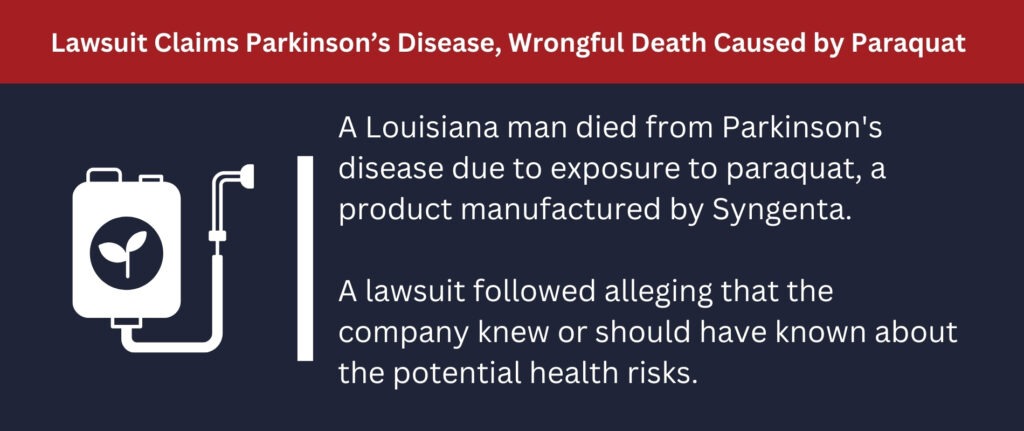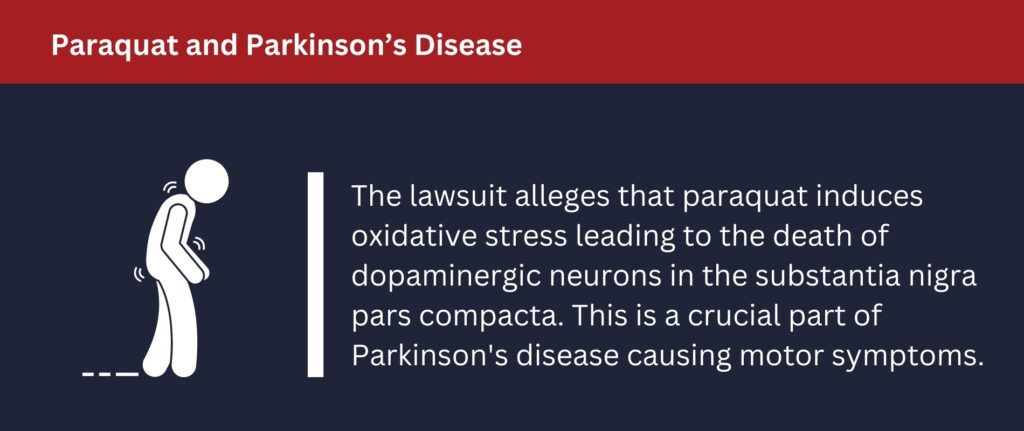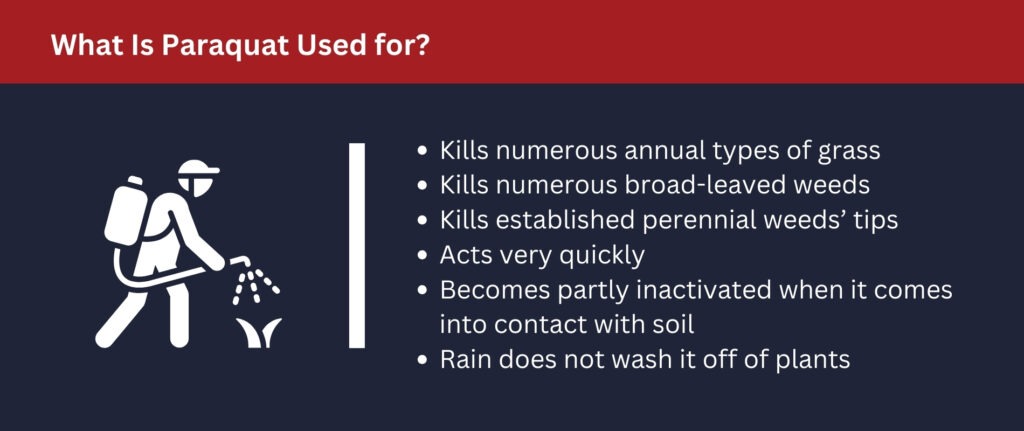
A wrongful death lawsuit filed in United States District Court, Southern District of Illinois on July 19 claims that a Louisiana man developed Parkinson’s disease and died from the disease as a result of his exposure to paraquat. The lawsuit was filed against Syngenta.
The lawsuit is now one of around 1,300 lawsuits that have been filed naming Syngenta as the defendant. The lawsuits accuse Syngenta of manufacturing and selling products containing paraquat without warning that it may cause Parkinson’s disease. The lawsuits also allege that Syngenta knew or should have known that paraquat may cause Parkinson’s disease.

The lawsuit seeks to recover:
- Compensatory or actual damages in an amount determined by trial
- Punitive and exemplary damages that will adequately deter and punish the defendants and others from behaving similarly in the future
- Post-judgment and pre-judgment interest
- Costs such as court costs, attorneys’ fees, and other litigation-related expenses
- All other relief deemed proper and just by the court
Paraquat Exposure
Paraquat is an herbicide that is usually sold as a liquid, which is diluted with water after or before loading it into a sprayer tank. The herbicide is then sprayed onto weeds.
Products containing paraquat are usually applied with a hand-held sprayer, a knapsack sprayer, a truck, aircraft, or a tractor.
The lawsuit claims that it was reasonably foreseeable to Syngenta that paraquat applicators, as well as those near paraquat application, would be exposed to paraquat via skin contact, inhalation or ingestion when it was used as instructed or in a reasonably foreseeable manner.
Parkinson’s Disease
The lawsuit describes Parkinson’s disease as “a terrible disease,” which is a progressive neurodegenerative brain disorder affecting the motor system. The motor system is part of the human central nervous system and it controls movement.
The primary motor symptoms of Parkinson’s disease are:
- Resting tremor (shaking movements even with relaxed muscles)
- Bradykinesia (slow reflexes and voluntary movements)
- Rigidity (stiffness)
- Postural instability (balance issues)
These primary symptoms lead to secondary symptoms such as:
- Shrinking handwriting
- Freezing of gait
- A quiet, monotonous, slurred voice
- Mask-like expression
- Muscle spasms
- Stooped posture
- Difficulty swallowing
- Impaired coordination
- Drooling and excess saliva due to a reduction in swallowing movements
The disease can also cause non-motor symptoms such as:
- Constipation
- Altered sense of smell
- Loss of smell
- Depression
- Sleep disturbances
- Low blood pressure after standing up
There is no cure for Parkinson’s disease, and the progression of the disease cannot be stopped or slowed. Existing treatments, which may produce unpleasant side effects when they are used long-term, only partially and temporarily relieve the disease’s motor symptoms.
Paraquat and Parkinson’s Disease

One of Parkinson’s disease’s “primary pathophysiological hallmarks,” according to the lawsuit, is dopaminergic neurons dying in the section of the brain known as the substantia nigra pars compacta. Dopaminergic neurons are neurons that produce dopamine, a neurotransmitter that the brain needs to control motor function.
Dopaminergic neurons are not replaced by the body when they die and, according to the lawsuit, Parkinson’s disease’s motor symptoms are the result when dopamine levels fall too low due to the death of dopaminergic neurons.
According to the lawsuit, dopaminergic neurons can be killed by oxidative stress. The lawsuit alleges that paraquat induces oxidative stress in plants, animals, and humans.
Paraquat has “redox properties” that create “redox cycling” in living cells. This endless, repeating cycle creates superoxide radicals, leading to oxidative stress and the death of dopaminergic neurons. Since this cycle repeats indefinitely in living cells, a single paraquat molecule can trigger countless superoxide radical molecules’ production.
Lawsuit Claims Syngenta Knew or Should Have Known That Paraquat May Cause Parkinson’s Disease
The central claim in the lawsuit is that Syngenta knew or should have known that paraquat may cause Parkinson’s disease yet failed to warn about it.
The lawsuit claims that paraquat’s redox properties have been known by the scientific community since the 1930s and that the scientific community has been aware since the 1960s that paraquat is toxic to humans because its redox cycling creates oxidative stress.
The lawsuit claims that scientists literally give paraquat to animals in order to produce Parkinson’s disease symptoms in the animals so that the scientists can study the symptoms.
According to the lawsuit, paraquat has been linked to oxidative stress and the death of dopaminergic neurons by “hundreds” of studies. The lawsuit also claims that numerous epidemiological studies have linked paraquat exposure with a higher risk of developing Parkinson’s disease.
Causes of Action

The lawsuit seeks to recover damages based on multiple causes of action, including:
- Negligence: The lawsuit claims that Syngenta negligently failed to adequately test products containing paraquat and negligently failed to warn about the risk of developing Parkinson’s disease associated with paraquat.
- Strict liability (design defect): The lawsuit seeks to hold Syngenta strictly liable for damages caused by paraquat, claiming that products containing paraquat are defective by design because they can cause Parkinson’s disease when used as instructed or in a reasonably foreseeable manner.
- Strict liability (failure to warn): The lawsuit seeks to hold Syngenta strictly liable for harm caused by paraquat, claiming that Syngenta knew or should have known paraquat may cause Parkinson’s disease but failed to warn about it.
- Violation of Illinois Consumer Fraud and Deceptive Business Practices Act: The lawsuit claims that Syngenta used misleading and/or false descriptions or representations of fact that caused or probably caused customers to be confused regarding paraquat’s safety.
- Breach of implied warranty of merchantability: The lawsuit claims Syngenta warranted that paraquat was safe when it is not.
- Willful and wanton conduct: The lawsuit alleges that Syngenta, intentionally or with reckless disregard of the plaintiff’s safety, knew or should have known that paraquat may cause Parkinson’s disease and failed to warn about this danger.
- Punitive damages: The lawsuit seeks to recover punitive damages to punish Syngenta and deter others from behaving as Syngenta did.
Frequently Asked Questions
What Is Paraquat?
What Is Paraquat Used for?
Is Paraquat in Roundup?
What Crops Are Paraquat Used On?
What Products Contain Paraquat?
When Was Paraquat First Used?
Where Was Paraquat Used?
Who Makes Paraquat?
What Is a Paraquat Settlement?
Is Paraquat Agent Orange?
Is Paraquat Still Used?
Is Paraquat Used on Golf Courses?
Does Paraquat Cause Parkinson’s?
Is Paraquat Banned in the U.S.?
How Much Do Paraquat Lawyers Cost?
What Is Paraquat?
Paraquat is one of the most commonly used herbicides in the world. It is also known as N,N′-dimethyl-4,4′-bipyridinium dichloride or methyl viologen. Its chemical formula is [(C6H7N)2]Cl2.
Paraquat, as an herbicide, acts quickly and non-selectively, killing green plants on contact. It is also toxic to animals and humans.
What Is Paraquat Used for?

Paraquat is used as an herbicide. It was originally synthesized in 1882. However, it was not recognized that it is an effective herbicide until 1955. It was first sold as an herbicide in 1962 under the name Gramoxone.
Paraquat has characteristics distinguishing it from other herbicides, such as:
- It kills numerous annual types of grass
- It kills numerous broad-leaved weeds
- It kills established perennial weeds’ tips
- It acts very quickly
- It becomes partly inactivated when it comes into contact with soil
- Rain does not wash it off of plants
Paraquat is used in no-till farming due to these characteristics. Its use is restricted in the United States. Only licensed applicators can use paraquat in the U.S. About 10,000,000 pounds of paraquat are sprayed in the U.S. every year.
Paraquat functions as an herbicide via the inhibition of photosynthesis. When plants are exposed to light, paraquat accepts electrons from ferredoxin. It transfers them to oxygen, producing reactive oxygen species, which regenerates paraquat’s oxidized form as part of a cycle that induces necrosis in the plant.
Paraquat is often used to prevent weeds from becoming resistant to glyphosate and to kill weeds that have become resistant to glyphosate.
Is Paraquat in Roundup?
No. Paraquat is not in Roundup. The active ingredient in Roundup is known as glyphosate, and lawsuits claim that glyphosate may cause non-Hodgkin lymphoma, a type of cancer.
What Crops Are Paraquat Used On?
Paraquat is used on over 100 crop types, such as:
- Corn
- Sugar cane
- Soybeans
- Sorghum
- Peanuts
- Cotton
- Rice
- Citrus
- Wheat
- Sugar beets
- Strawberries
- Grapes
- Potatoes
- Artichokes
- Alfalfa
- Sweet potatoes
- Almonds
- Garlic
- Pears
- Potatoes
What Products Contain Paraquat?
Paraquat has been sold under many names, such as:
- Gramoxone
- Cyclone SL 2.0
- Para-Shot 3.0
- Parazone
- Devour
- Dexuron
- Crisquar
- Garmixel
- Tota-col
- Blanco
- Bai Cao Ku
- Pillarxone
- AH 501
- Esgram
- Ortho Paraquat CL
- PP148
- Firestorm
- Para-col
- Bonedry
When Was Paraquat First Used?
An herbicide called Gramoxone, which contained paraquat, was first manufactured by ICI in 1962.
Where Was Paraquat Used?
Paraquat is used all over the United States and in about 120 countries. However, paraquat use has been prohibited in:
- Kuwait
- Syria
- Brazil
- Slovenia
- China
- Finland
- Austria
- Malaysia
- Denmark
- Sweden
- Ivory Coast
- Germany
- Cambodia
- United Arab Emirates
- European Union
- United Kingdom
- Switzerland
Who Makes Paraquat?
Companies that have made products containing paraquat include:
- Chevron Chemical Company
- Syngenta
- Innvictis Crop Care
- Altitude Crop Innovations
- Helm Agro
- Adama Group
- Drexel Chemical Company
- Sinon USA
- United Phosphorus
What Is a Paraquat Settlement?
A paraquat settlement is when the manufacturer of a product containing paraquat agrees to pay somebody who has been harmed by paraquat in order to financially compensate them for the harm done to them by paraquat. Our lawyers can tell you more about paraquat settlements during a free consultation.
Is Paraquat Agent Orange?
No. Paraquat is not Agent Orange. Agent Orange is a different herbicide that is famous for its use during the Vietnam War.
Is Paraquat Still Used?
Yes. Paraquat is still used in about 120 countries, including the United States, despite scientific evidence suggesting it may cause Parkinson’s disease.
Is Paraquat Used on Golf Courses?
Paraquat used to be used on golf courses, but the EPA has banned that practice. If you or a loved one developed Parkinson’s disease after being exposed to paraquat at a golf course in the past, we can help.
Does Paraquat Cause Parkinson’s?
Paraquat exposure has been linked by over a dozen scientific analyses and studies to an increased risk of developing Parkinson’s disease.
For example, a 2011 study determined that people exposed to paraquat are 2.5 times more likely to develop Parkinson’s disease than people who aren’t exposed to paraquat.
Is Paraquat Banned in the U.S.?
Paraquat is not banned in the United States. However, its use is restricted, as it can only be applied by licensed applicators.
How Much Do Paraquat Lawyers Cost?
The paraquat lawyers at Nadrich Accident Injury Lawyers are representing those harmed by paraquat on a contingency fee basis. This means that we do not charge a fee to represent you until and unless we recover financial compensation for the harm done to you by paraquat.
In other words, you will not be charged a fee if we don’t win your case, so it will never cost you a single penny out of pocket for us to represent you.
Contact the Paraquat Lawsuit Lawyers of Nadrich Accident Injury Lawyers
Nadrich Accident Injury Lawyers have been representing victims of toxic exposure since 1990. We have recovered $750,000,000 on behalf of our clients. We have tremendous experience in recovering financial compensation for those harmed by toxic substances such as asbestos, Roundup, AFFF fire fighting foam, and toxic baby food.
Our lawyers are experts at obtaining financial compensation for our clients, including damages relating to:
- Medical bills
- Loss of wages
- Lost earning capacity
- Emotional distress
- Pain and suffering
- Loss of enjoyment of life
- Loss of companionship
If you or a loved one has been diagnosed with Parkinson’s disease after being exposed to paraquat, you need lawyers with decades of experience handling the complex legal issues that arise from hazardous exposure claims. You need Nadrich Accident Injury Lawyers.
Contact us today for a free consultation.

